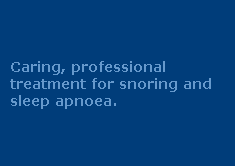Sleep Apnoea Symptoms
Sleep apnoea symptoms are relatively easy to identify, although far too often sleep apnoea symptoms are overlooked or not considered serious.
The first and most obvious symptom of sleep apnoea is heavy, habitual snoring. This is a particularly strong sleep apnoea symptom if the snorer is seen or heard to stop snoring for extended periods of time. Instead of simply being a brief period of respite from the snoring, it may actually be that the sufferer is experiencing an apnoeic event. This means the soft tissue of the upper airway (normally the tongue, soft palate, uvula and pharyngeal walls) have relaxed and / or collapsed into the airway and literally stopped the person's airflow. A classic sleep apnoea symptom is when a sufferer wakes choking and / or gasping after one of these events.
Another extremely common sleep apnoea symptom is waking tiredness. By rights, a healthy sleeper should wake feeling fully refreshed after their period of deep, restorative sleep. In sleep apnoea patients, the repeated breathing stoppages lead to 'micro arousals', which mean the body wakes sufficiently to start breathing again, but not enough for the sufferer to become aware of waking. As a result, many sleep apnoea sufferers perceive they are getting enough sleep - when, in fact, they are a ctually getting many short naps. The quality of their sleep is thus disturbed and the true restorative benefits are not enjoyed.
Excessive daytime sleepiness is another common sleep apnoea symptom. Because of the poor quality sleep experienced by the sufferer, it is common for them to fall asleep at the slightest opportunity. This can include while sitting in front of the TV, while sitting at the dinner table, during meetings and, most dangerously, while operating machinery or driving.
Another common symptom of sleep apnoea is nocturia, or frequent nocturnal urination. In a healthy sleeper, most nights should not be interrupted by the need to visit the toilet, whereas in sleep apnoea sufferers it is not uncommon for several trips to the toilet to be needed.
Waking with frontal headaches are an oft-reported symptom of sleep apnoea. These headaches usually pass shortly after waking, but their consistent recurrence is a distinct sleep apnoea symptom.
Hypertension, or consistent high blood pressure, is a common consequence and symptom of sleep apnoea. This is a natural response to the body's constant efforts to breathe while asleep and while the airway is collapsed.
In addition to these symptoms of sleep apnoea, there are numerous risk indicators which should also be looked for.
People who are obese or have a high Body Mass Index are at a significantly higher risk of having sleep apnoea. This is primarily because some of the fat deposits are stored in the areas of soft tissue mentioned above. This leads to a crowded airway and consequent restriction or obstruction of airflow.
People with Type 2 Diabetes are statistically at a higher risk of having sleep apnoea. The exact cause of this is not know, although a growing body of research suggests that the common link between obesity, type 2 diabetes and hypertension is, in fact, sleep apnoea.
As a very rough guideline, a person who snores and suffers from any of the other listed conditions is very likely to have sleep apnoea. A person who is obese, hypertensive and type 2 diabetic is almost certainly suffering from a significant form of sleep apnoea.
The only sure way to determine if a person has sleep apnoea is to undergo a diagnostic sleep study. If you wish to conduct a self-assessment prior to undergoing a diagnostic sleep study, try using our free self assessment tool.
For further information about the symptoms of sleep apnoea, or to arrange a diagnostic sleep study, call 1300 246 637 or contact us using the form below.

